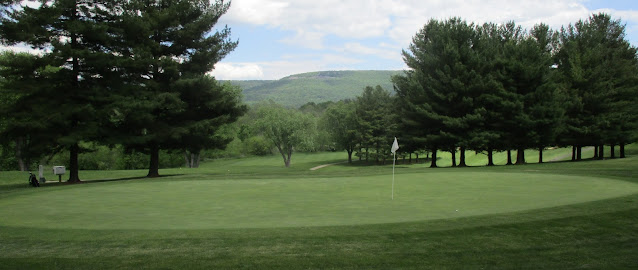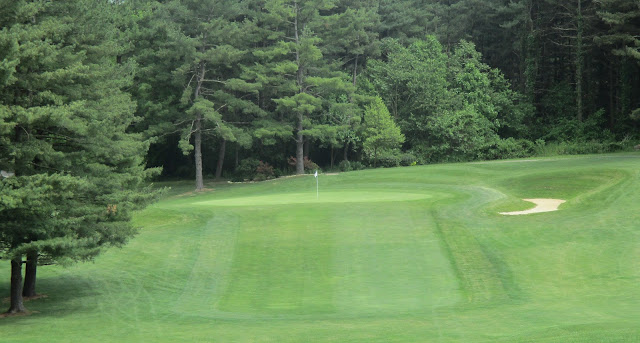This has been a long time coming.
There is no currently existent golf course on this planet that I've played more than Beaver Creek Country Club, located just outside Hagerstown, Maryland. And little wonder too, it was my home course for 6 years. I've played it literally hundreds of times. I know it like the back of my hand.
But all things come to an end, and for now at least, I've moved on from Beaver Creek. And so, to close out 2024, it's finally time to look back and review the course.
One thing to note before we get into the review: Beaver Creek has flipped its nines multiple times over the years. The first time I played it, back when I was a junior golfer, the front nine as presented here was the back nine. It was switched to this configuration literally a week or two after I purchased a membership here. Then, a month after my membership lapsed, they switched the nines back. But I'm going to present the course as I know it best.
The first hole is a 430-yard par 4 that plays straight away down and then back up out of a valley. The tee shot is relatively open, in that there's quite a bit of space to work with, but the penalty for missing that corridor is very high. Unlike most courses in the area, Beaver Creek is dominated by pine trees; these trees are planted in closely packed clusters and feature branches pretty close to the ground. They're extremely difficult to play out of. So while there are no fairway bunkers, the hole does not need them. Anyway, a solid drive will leave a short iron back up the hill to a fairly flat green flanked by sand. It isn't exactly an enormous challenge, but this is far from a gentle opening hole.
 |
| The first hole. If the photo quality feels a little off, that's because these photos are from June 2020 and were taken with my old camera. |
 |
| Approaching the first green. |
 |
| The first green. |
The second hole is the longest hole on the course, playing nearly 560 yards along the side of a hill. The drive is pretty steeply downhill and plays to a fairly narrow fairway with trees encroaching more and more the further you go. You really don't want to miss right, but at least the slope of the hole does help you come back toward the fairway. A solid drive, likely hit with a 3 wood as the fairway ends about 300 yards out, will leave a steeply uphill second toward the green. This green is tiny and domed, making it next to impossible to hit in two; the best play is a lay-up to around a hundred yards. Again, the upper fairway slopes hard from right to left, especially the further left you go. The right side is flatter, but there's O.B. pressed up against the fairway to make that option less appealing. All in all, this ends up being a pretty difficult par 5.
 |
| The second hole. The largest tree in the right center of the photo is no longer there; it was knocked over in a thunderstorm. |
 |
| Approaching the second green. |
 |
| The second green. |
The third hole is the last hole in a stern opening stretch. Playing as long as 470 yards (though I don't think I ever saw it stretched out quite that long), this is the longest par 4 on the course. The tee shot is downhill, just like the previous two holes, but the inside of the dogleg is closely guarded by a cluster of dense pines (the same trees protecting the left side of the previous hole). Hit even the slightest hook on this tee, and you won't be going for the green in regulation. A solid drive hit safely to the middle of the fairway will leave a mid or long iron up the hill to a green that's sharply sloped from back to front and protected by sand on both sides.
 |
| The third hole. |
.
 |
| Approaching the third green. |
 |
| The third green. |
Where the first three holes were quite difficult, the next three, starting here with the fourth, represent the course's easiest stretch. There's nowhere better to make birdies. The fourth is 360 yards and plays to an initially very wide playing corridor. But as you get beyond 250 yards and the top of the little ridge cutting across the fairway, a single massive tree left and a cluster of pines right significantly narrow your options. The best play is to try to reach the top of the ridge, leaving yourself a level stance and a clear view of the green. You can absolutely hit driver and try to get close, but that leaves an awkward little pitch to a small green with bunkers front left and front right. Not that it can't be done, but the full wedge from a hundred yards out is probably the easier play.
 |
| The fourth hole. |
 |
| The fourth green. |
Back in the day, the fifth hole used to have a massive tree protecting the right side of the green, but that's been gone a long time. Without it, this 165-yard par 3 really has nothing protecting it beyond the golfer's own ability. There are no trees, no bunkers, and not even the green has anything really going for it. There really is no better birdie opportunity than this, provided you can execute on the tee shot. Of course, that's the tricky bit, actually hitting the shot you need to hit.
 |
| The fifth hole. |
 |
| The fifth green. |
The sixth hole is the shortest of Beaver Creek's par 5s, playing just over 500 yards. For me, the tee shot from all the way back was always tremendously awkward, as there are trees overhanging from the left, essentially forcing you to aim out at the pine trees right of the landing area and draw it back in. This is a shot I did not have. But if you can pull that shot off and catch the big downslope about 250 yards out, your ball will kick down within 200 yards of the green, leaving yourself a mid iron back up the hill toward the green. That second shot is even more inviting now than when this picture was taken; while the cross bunker 30 yards short and the two bunkers right of the green are still there, a tree protecting the front-left portion of the green is now gone, meaning you have much more room to fade a shot into the green, hopefully taking the sand out of play. The natural slope of the hole will guide long shots in, even if they do miss a little left. The previous hole may theoretically be easier, but in reality, this is the course's best birdie (or even eagle) opportunity.
 |
| The sixth hole. |
 |
| Approaching the sixth green. |
 |
| The sixth green. |
The seventh hole is a long, 230-yard par 3 that plays slightly downhill across a valley to a shallow green carved into the hillside, with deep bunkers on either side. It's got quite a bit of slope from back right to front left, making misses out to the right especially challenging to recover from. This hole was my younger brother's kryptonite back in his junior golf days (he played Beaver Creek a lot more in his younger days than I did); I don't know exactly how many times he played (let's say 50 just to throw a number out), he never once hit this green in regulation. Which is honestly fair, as this is a very difficult green to hit.
 |
| The seventh hole. |
 |
| The seventh green. |
The eighth hole is 420 yards and plays to a narrow fairway squeezed between a line of trees left and marsh right. While there's never much room to work with, the fairway gets even narrower at about 150 yards from the green; this makes 3 wood the obvious play. Sure, that leaves a mid iron into the green, but better that than losing a golf ball or ending up underneath a tree. The green is elevated with a bunker left and a very deep bunker right. That right bunker is a mercy, because if you miss right and catch the 20-foot-high slope down, you'll at best have a very tough pitch back up toward the green. Overall, this is a hole to play cautiously.
 |
| The eighth hole. |
 |
| Approaching the eighth green. |
 |
| The eighth green. |
The ninth hole isn't a long par 4 at 370 yards, but it effectively plays longer thanks to the 90-degree bend in the fairway about 225 yards out. Driver is 100% out, and even 3 wood is tough to justify unless you can hit a big slinging hook around the trees. A long iron is really the only practical play. That will leave you a second of about 150 yards from a level stance. The green here is on the far side of a valley; it's shallow and sloped pretty heavily from back to front, with a single bunker short right.
 |
| The ninth hole. Yes, I played this hole a million times and this is the only decent picture I got. |
That's it for this week, next week we'll take a look at the back nine.























No comments:
Post a Comment